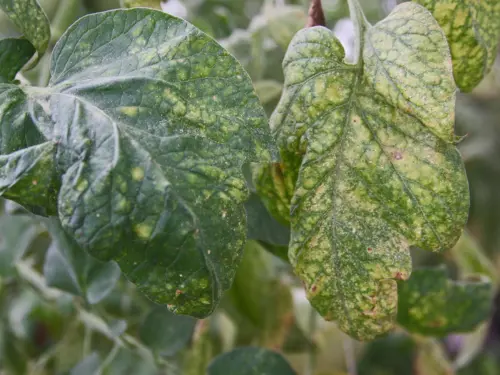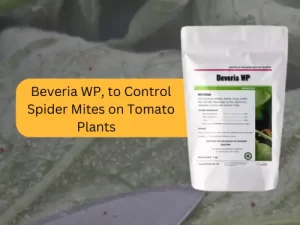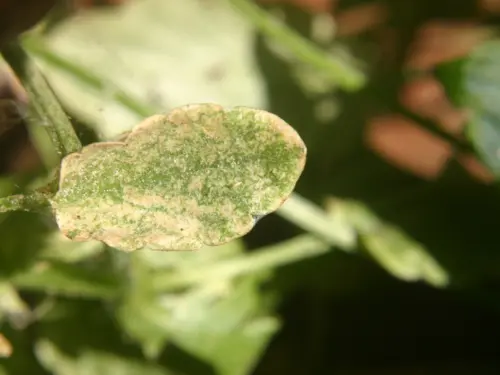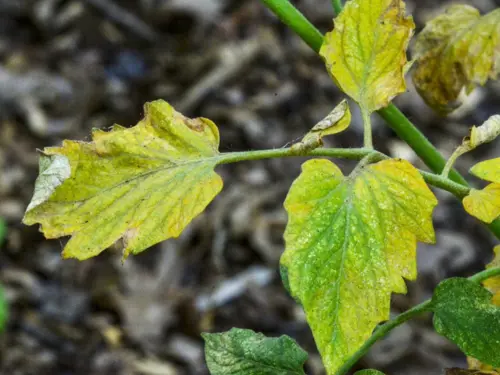Spider mites on tomato plants are a significant threat, feeding on plant juices and causing yellowing leaves and reduced vigor. These pests thrive in warm conditions, making early detection and intervention crucial. Effective management includes the use of organic pesticides like neem oil, which controls mites without harming beneficial insects. Maintaining plant health and employing preventive measures are fundamental to safeguarding tomato plants against the damaging effects of spider mite infestations.

| Spider Mites on Tomato | Effects |
| Yellowing of leaves | Reduced plant vigor |
| Stippling on leaves | Impact on fruit quality |
Importance of timely and effective control measures.
Early detection and timely intervention are paramount for controlling spider mites, preventing stunted growth and yield reduction. Utilizing organic pesticides like insecticidal soap, neem oil, or horticultural oil, along with BEVERIA WP, Beauveria Bassiana, ensures the health of beneficial insects. Proactive pest management minimizes severe infestations, safeguarding plant health and productivity. In conclusion, prioritizing biological and cultural methods offers sustainable control of spider mites on tomato plants.
To manage spider mites, early detection through signs like webbing and leaf speckling is crucial. Maintaining plant health and minimizing stress through proper watering and fertilization can deter mites. Regular monitoring and the introduction of natural predators such as lady beetles aid in controlling infestations. Avoiding broad-spectrum pesticides preserves beneficial insects, crucial for sustainable spider mite management. Early identification and preventive measures are key to protecting tomato plant health and productivity.
| Strategy | Description | Importance |
| Proper watering | Ensuring plants receive adequate but not excessive water to maintain essential health. | High |
| Organic fertilization | Using natural fertilizers to provide necessary nutrients without causing stress to the plants. | High |
| Beneficial insects | Introducing natural predators like lady beetles and predatory thrips to control spider mite populations. | Medium |
When combating spider mites on tomato plants, adding beneficial insects like ladybugs and lacewings can help control infestations naturally. Moreover, using spider mite insecticides, such as Novobac’s product containing Beauveria bassiana, can be effective in managing spider mite populations without harming the environment. These biological control methods offer sustainable solutions for controlling spider mites.
Introduction of beneficial insects like ladybugs and lacewings.
The introduction of beneficial insects like ladybugs and lacewings provides a natural and effective biological control method for managing spider mites on tomato plants. Ladybugs and lacewings are natural predators that feed on spider mites, thereby helping to control their population efficiently. By bringing in these beneficial insects to your garden, you can establish a sustainable and eco-friendly solution to combat spider mite infestations.
Ladybugs and lacewings are known for their voracious appetite for soft-bodied pests like spider mites, reducing the reliance on chemical spider mite pesticides. These beneficial insects are readily available for purchase from gardening stores or online suppliers, allowing for their release in the garden to address spider mite outbreaks. Encouraging a diverse ecosystem with natural enemies such as ladybugs and lacewings helps maintain a healthy balance and prevent severe spider mite damage on tomato plants.

BEVERIA WP, insecticide for spider mites, stands as a potent spider mite insecticide, harnessing the natural prowess of Beauveria bassiana, a fungus found ubiquitously in soils around the globe. This eco-friendly biopesticide offers superior suppression of a wide array of insect pests, including whitefly, thrips, aphids, spider mites, psyllids, mealybugs, leafhoppers, and Lepidoptera. Its safety profile for both indoor and outdoor vegetation positions BEVERIA WP as a premier choice for organic pest management in homes, gardens, and agricultural settings.
Targeted Pests:
Mechanism of Action:
Upon application, Beauveria bassiana spores cling to insects, penetrate their shells, and release metabolites that kill the pest. This fungal action ensures sustained pest management across a variety of species.
Advantages:
BEVERIA WP, insecticide for spider mites, presents a sustainable, benign approach to pest control, eliminating the concern for harmful chemical residues. Its broad-spectrum efficacy against numerous pests makes it an optimal solution for safeguarding indoor plants and edibles. As a cornerstone of integrated pest management (IPM) strategies, it harmonizes with both chemical and biological treatments.
Application Instructions:
For those seeking a natural, effective solution for plant pest management, Novobac emerges as a trustworthy provider of BEVERIA WP, offering a robust, environmentally friendly alternative to conventional spider mite pesticides.

In implementing cultural practices, it is crucial to regularly monitor the plants for early detection of infestations. Maintaining proper humidity levels can help deter spider mites from thriving on the plants. Moreover, pruning infested foliage can effectively reduce mite populations and prevent further spread.
Regular monitoring of plants for early detection.
Amidst the cultivation of tomato plants, a fundamental practice critical for effective pest management is the routine monitoring of foliage to promptly identify and address the emergence of spider mite infestations. Regularly inspecting the tomato plant leaves for characteristic stippling patterns and checking the undersides for tiny red or black specks are crucial steps in early detection. Quick action upon spotting spider mites can prevent extensive damage to the plants. Implementing regular checks for spider mites is a key cultural practice in controlling infestations. Below is a visual representation of the monitoring process:
Maintaining proper humidity levels to deter spider mites.
Keep humidity under 60% to deter spider mites on tomato plants effectively. Spider mites love dry conditions, so increasing humidity can create an unfavorable environment for infestations. Methods such as misting plants or using a humidifier nearby can help raise humidity levels effectively.
Consistent monitoring of humidity levels in the growing area is crucial to prevent spider mite infestations. By keeping the air moisture balanced, the likelihood of spider mites colonizing and damaging tomato plants is reduced. Ensuring that the humidity remains within the recommended range is a proactive approach to deterring these pests and maintaining the health of tomato plants.
| Monitoring Steps | Description |
| Inspect leaf surfaces | Look for stippling patterns caused by mites |
| Check undersides of leaves | Search for tiny red or black specks |
| Monitor plant growth and health | Note any changes that may indicate infestation |
| Take corrective action promptly | Use appropriate measures to control mites |
| Record observations | Keep track of monitoring results for future reference |

In summary, an integrated pest management approach is the best treatment for spider mites for controlling spider mites on tomato plants. Biological and cultural methods should be prioritized as sustainable strategies to manage these pests. By emphasizing early detection, timely intervention, and collaboration within gardening communities, the impact of spider mite infestations can be minimized, promoting healthier tomato plants.
Encouraging the use of biological and cultural methods as primary strategies for sustainable control of spider mites on tomato plants.
Encouraging the adoption of biological and cultural methods as primary strategies for sustainable control of spider mites on tomato plants enhances the ecological balance in the garden while effectively managing pest populations. Biological control through the introduction of predatory insects like lady beetles can help mitigate spider mite infestations naturally. Incorporating cultural practices such as companion planting with marigolds or garlic acts as a natural deterrent to spider mites, promoting a healthier garden ecosystem.
Additionally, practices like crop rotation and maintaining proper plant spacing can decrease the likelihood of spider mite outbreaks and restrict their spread among tomato plants. Biodiversity plays a critical role in attracting beneficial insects that prey on spider mites, contributing significantly to their control. Regular monitoring and early intervention are key to preventing severe infestations and preserving the health of tomato plants.
As a plantation owner, I face quite a few..
The banana weevil, also known as Cosmopolites sordidus, is..
Fusarium wilt in banana is usually known to be..

Leave a Reply